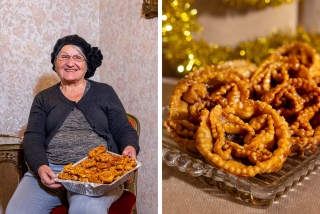What’s a Bottarga?
- Share via
For those of us who love food and study its history, one of the most vexing questions is how an ingredient of humble origins suddenly becomes a sought-after delicacy that appears on fancy tables from L.A. to London. As often as not, the ingredient’s original purpose is forgotten because chefs don’t bother to find out how it is used in its native land.
A famous example of this phenomenon is the sun-dried tomato, which was traditionally used to save tomato flavor for the time of year when it is unavailable fresh. The dried tomatoes were softened in water, then cooked to make a sauce. It would never occur to an Italian to eat the musty-tasting leathery chunks of sun-dried tomato that American chefs toss over food as if they were rolling dice.
The current example of culinary lost-in-translation is bottarga, the pressed dried eggs of tuna or gray mullet. It is popular in coastal areas of Italy, especially Sardinia, Sicily, Liguria and Calabria, where it is called ovotarica. Bottarga is a legacy of privation, when no part of the fish was ever discarded. Yet, when combined with particular local ingredients, it proved quite delicious when used sparingly.
Bottarga from tuna has a bracing maritime flavor (and is preferred by Sicilians) while bottarga from mullet (usually found in Sardinia and Liguria) is more delicate. The most prized mullet bottarga comes from Carloforte, in southern Sardinia, and Cabras, on the island’s west coast.
Bottarga is made by carefully removing roes from the fish, rinsing and salting them and then leaving them to dry for two days. They are then pressed between pieces of wood to give them a long, rectangular shape and a thickness of about 1 1/2 inches. Once the roe has taken this form, it is hung to age. The mullet roe will be dipped in wax to maintain the shape and prevent it from drying out.
After careful aging for up to five months, bottarga will have a deep orange color and be quite firm to the touch. It is served by slicing it paper-thin (from top to bottom) with a sharp knife.
Only when presented this way can its subtle flavors and texture be admired as it dissolves on the tongue. Profligate American chefs like to serve bottarga in small chunks that rightfully should appeal only to an undiscerning cat.
Although bottarga is best known in the Italian kitchen, it is also enjoyed elsewhere in the Mediterranean. Since ancient times it has been one of Egypt’s exports to the rest of the Mediterranean; its name comes from the Arabic bata^rikh, which in turn comes from the Greek tarikhos, “dried,” plus the ancient Egyptian definite article.
Dried fish roe is an essential ingredient in Greece’s taramosalata. The British, who imported it to serve with ale, once called it poutarg (from the French form of the word, boutargue) and now refer to it as botargo. We Americans prefer the Italian name.
In Italy, the classic preparation for bottarga involves tossing it with delicate strands of pasta and olive oil. But it makes a fine appetizer with crostini and butter. It also pairs beautifully with the flavors of tomato, celery, parsley and citrus fruit.
The most suitable wine for bottarga is excellent Vermentino di Gallura from Sardinia, although Vermentinos from Liguria and Tuscany work well too. Pinot Grigio or Malvasia Istriana from Friuli-Venezia Giulia are also suitable. A California Chenin Blanc is another good choice, provided that it is has not been aged in wood.
Bottarga is typically vacuum-packed for export. Once you have opened it, do not keep it exposed to air for longer than necessary. Wrap the piece you do not use in lots of plastic and store in the refrigerator for up to a week.
Spaghettini Con Bottarga
Adapted from “La Cucina Siciliana di Gangivecchio” by Wanda and Glovanna Tornabene with Michele Evans (Knopf, 1996).
Active Work Time: 15 minutes * Total Preparation Time: 25 minutes
1 cup extra-virgin olive oil
3 cloves garlic, chopped
1/2 cup grated bottarga, plus more for topping
1/2 cup chopped Italian parsley
Freshly ground pepper
Water
Salt
1 pound spaghettini
* Place oil and garlic in large skillet and cook over medium heat 5 minutes, stirring often and taking care that garlic does not burn. Add bottarga. Toss and cook 1 minute. Turn off heat and stir in parsley and dash pepper.
* Bring at least 4 quarts cold water to a rolling boil. Add dash salt and, when water returns to a boil, add spaghettini. Cook until al dente (check package for recommended time), stirring frequently.
* Reserve 1 cup cooking water from pasta. Drain spaghettini, then add to skillet. Toss well and cook over high heat 1 minute, adding a little pasta water, if necessary. Transfer pasta to serving dish and sprinkle with a little more shaved bottarga. Serve immediately.
6 first-course servings or 4 main-course servings. Each of 4 servings: 732 calories; 559 mg sodium; 188 mg cholesterol; 60 grams fat; 37 grams carbohydrates; 14 grams protein; 0.41 gram fiber.
Crostini With Bottarga
Active Work Time: 15 minutes * Total Preparation Time: 25 minutes
This bottarga butter is also very nice tossed with pasta or rice.
3/4 cup (1 1/2 sticks) butter, softened
1/2 cup shaved bottarga
12 to 16 slices day-old unseeded Italian bread or baguette
* Combine softened butter and bottarga thoroughly in glass or metal mixing bowl. Cover it tightly with plastic and place in refrigerator until needed.
* Toast bread until golden but not burned. Spread bottarga butter on top and serve immediately.
12 to 16 crostini. Each of 16 crostini: 146 calories; 298 mg sodium; 0 cholesterol; 10 grams fat; 11 grams carbohydrates; 4 grams protein; 0.50 gram fiber.
Stuffed Tomatoes With Bottarga
Active Work Time and Total Preparation Time: 40 minutes
6 tomatoes
Coarse salt
1/2 cup thinly sliced celery
1/2 cup minced Italian parsley
1 cup cooked baby shrimp
1/2 cup shaved bottarga
2 tablespoons extra-virgin olive oil
2 tablespoons lemon juice
Freshly ground pepper
* Core tomatoes and add a dash salt to cavity of each. Turn them over onto paper towels so that seeds and liquid drain out. Discard these. Scoop some of flesh out of each tomato and mash in a large mixing bowl.
* Add celery, parsley, shrimp and bottarga to bowl and toss lightly just until ingredients combine. Add oil, lemon juice and pepper to taste and combine thoroughly.
* Carefully stuff cavity of each tomato with filling and serve.
6 appetizer servings. Each serving: 125 calories; 498 mg sodium; 153 mg cholesterol; 9 grams fat; 5 grams carbohydrates; 9 grams protein; 1.05 grams fiber.
Oranges With Bottarga
Active Work and Total Preparation Time: 15 minutes
You might want to use less bottarga because it is strong.
3 medium-large oranges suitable for slicing, such as navel
1/2 cup shaved bottarga
Extra-virgin olive oil
* Peel oranges and carefully remove any white membrane. Cut oranges vertically into 1/4-inch slices. Remove any seeds and place slices on 6 serving plates.
* Distribute shavings of bottarga evenly over orange slices, which should be mostly covered. Add more bottarga if necessary. Top each orange slice with just a drop or two of olive oil (be very stinting) and serve.
6 appetizer servings. Each serving: 98 calories; 320 mg sodium; 125 mg cholesterol; 5 grams fat; 9 grams carbohydrates; 6 grams protein; 0.28 gram fiber.
(BEGIN TEXT OF INFOBOX / INFOGRAPHIC)
WHERE TO FIND BOTTARGA
Though bottarga is becoming better known in the United States, it is still difficult to find. Here are some places to check.
* Surfas Restaurant Supply and Gourmet Food, 8825 National Blvd., Culver City. (310) 559-4770.
On the Internet:
* https://www.Chefshop.com, or (877) 337-2491
* https://www.Ethnicgrocer.com, or (800) 523-1961
* https://www.Farawayfoods.com, (650) 344-1013
* https://www.Zingermans.com, (877) 665-3213
More to Read
Eat your way across L.A.
Get our weekly Tasting Notes newsletter for reviews, news and more.
You may occasionally receive promotional content from the Los Angeles Times.










